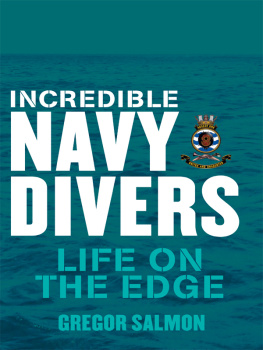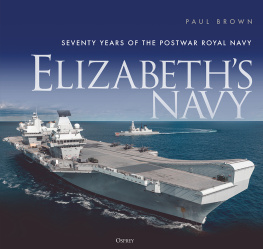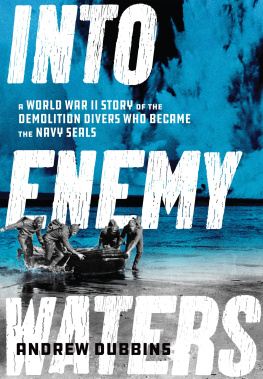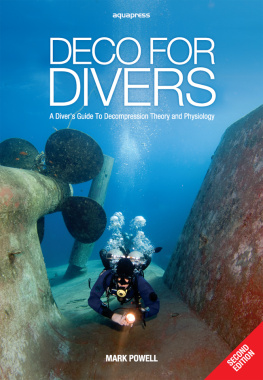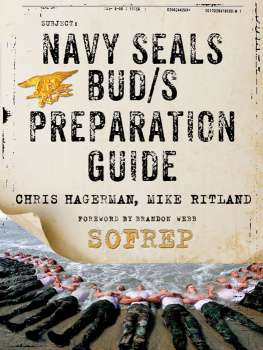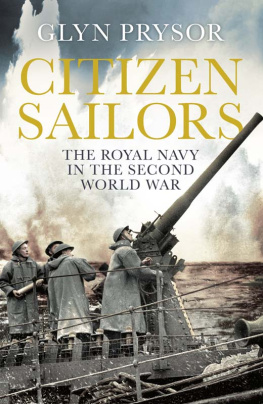LIFE ON THE EDGE
T HE DAYS FOR the Porpoise crew were full. In Sydney Harbour they learned how to search for underwater mines and render them safe. Out at the armys Holsworthy artillery range, they practised their disposal skills on unexploded bombs. British commandos taught them rappelling and beach reconnaissance. Ship attack, considered very glamorous after the war, was a must. Underwater ship repair was also on the curriculum. Demolition classes were centred on a sunken wreck off Chowder Bay. The brick-shuddering blasts didnt win them too many friends in the shoreline neighbourhoods, but they did deliver plenty of fish. The blast catch became fare for the Friday afternoon barbecues they held. Elsewhere in the clean and bountiful harbour, a harvest of oysters, mussels and lobsters could be added to the menu. The testing life certainly had its perks.
Diving was, of course, their main activity. If they werent out on a dive they were preparing for one. Most days they spent four hours under water and conducted at least one night dive a week. They readied their own rigs and filled their own cylinders using a mechanical pump. Then it was into the water in shifts: one team laying a dummy minefield and then another swimming string, doing jackstay searches, to find and clear them. However, one drill in particular was paramount: the oxygen swim.
Swimming on pure oxygen was always an inherently dangerous task, so mastering the rebreather was essential. From day one the divers had to learn how to follow a given compass bearing while maintaining a safe depth of no more than eight metres. Having no reliable depth gauges, they had to do this by sight, and it was a pretty rough guide: if they couldnt see the shimmer of the surface, they knew they were too deep. The air bag was also the divers buoyancy control vest. He had to balance how much gas he let into the bag against how much he consumed by breathing. This was particularly hard at shallow depths when trying to stay covert and not break the surface. All up, oxygen swims honed a divers navigational skills, depth maintenance and diving discipline.
In September 1955, eleven volunteers qualified as clearance divers. Australia had its first clearance diving team. From the eighteen starters, six had withdrawn during the course and one had deserted the navy altogether. Individually, every diver was proud to pass, but the success of the unit had become their collective cause. They desperately wanted to stick it up anyone who ever doubted them. That same year, the Siebe Gorman hard-hat rig was removed from all Australian ships. The copper helmet and canvas suit ensemble was consigned to the museum. Standard diving itself would soon follow.
Navy divings generation-next was on its feet. Working out in the open on Clarke Island, they operated in full view of the Fleet Commanders office at Garden Island and the general public, at least waterside residents and harbour-goers. Wider knowledge of who they were and what they did remained limited. The sight of specialist divers setting up camp in the middle of Sydney Harbour piqued the interest of the press. Despite Batterham being tight-lipped about his frogman school the navy wanted the nitty-gritty of their affairs kept under wraps a few admiring write-ups appeared. But what really mattered to the divers at this point was their internal validation and establishing an indispensable role for themselves within the navy a feat no amount of column inches could achieve.
One sure way to win a captains respect is to sink his ship, right under his nose. It wont be a warm-and-fuzzy kind of respect, but it will be won nonetheless. When the clearance divers were given any opportunity to conduct attacks on fleet ships, they made the most of it. Ship attacks were operation awkward exercises designed primarily to test and tighten the defensive regimen of the ships crew, so the divers success had to come at the expense of the crews pride.
Whenever a ship attack was planned, a date was set and the ships crew was put on full alert. They knew that at some stage during the night the clearance divers would be coming to lay dummy limpet mines on the hull. The sailors would have their underwater lights on, spotters at all points and a patrol boat in the water. The standard defence tactic of dropping explosives overboard was, of course, not allowed.
The divers staked everything on these raids. Typically they would approach the target ship at Garden Island from three points and, to their credit, they were always able to lay their mines and were seldom caught. These were chastening defeats for the ships crew, particularly the standard divers onboard who had to search the hull to confirm the mines had been attached. The navy brass was impressed, though. The new breeds reputation was building.
Following the successful graduation of the first clearance divers, the navy cut the standard diving qualification courses altogether. The ranks of the hard-hats began to migrate over to the new branch. Most assumed their transition would be a mere formality, but many failed to make the cut. That said, the clearance diving branch was particularly blessed to have two who did: Raymond Foord and Leo Brennan. These two men became so thoroughly admired that their better values became those of the branch itself. Foords passion for bomb and mine disposal helped enshrine the craft as the divers core value, while Brennan was the amiable, quiet achiever, the ultimate can-do operator. So, while effectively dancing on standard divings grave, clearance diving did well to inherit a heavy dose of hard-hat spirit.
The six-month course was held every year and soon gained widespread notoriety for its toughness and high failure rate. Many eager young men saw themselves as divers, but when asked to keep going and going alone under water, when it was pitch black and stone cold, many reconsidered. They were never kicked off course; they had to walk away of their own accord. This ensured that a supervisor didnt reject a potentially excellent diver who was merely exhausted, cold and wondering whether he should give up. You just never knew if and when the student would find his second, third or fourth wind.
Every course was an endurance test that ran from April through to October. Wetsuits only started to appear around 1960, but they did have drysuits. These were fully sealed rubber suits that you could wear a layer of clothing underneath. Still, they were not exactly toasty. The water temperature in the harbour throughout the year varied between fourteen and twenty-three degrees Celsius, but the water in the graving docks of Garden Island could get much colder. Like in backyard swimming pools, the water temperature in that environment would get close to the ambient temperature. To dive a dock on a Monday morning in winter felt like a dip in the Arctic.

